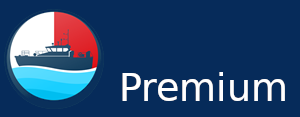Photos and article by Capt. Santosha K Nayak from his book "Theory and Practices of Marine Pilotage" (link below)
Pilot transfer arrangement is a sensitive topic to be discussed among the pilot’s fraternity. Although ships are designed and operated with compliance to the SOLAS requirements in all respects including the pilot transfer arrangements, there has been numerous deficiencies observed related to pilot transfer arrangements. The small deficiencies from the part of ships cause life threatening accidents for pilots and sometimes to the ship staff themselves. There are many instances of defective ladder and complacency in proper rigging of ladders has been reported almost every day in different parts of the world. Many pilots lost their life, severely injured for life and face many minor to major accidents. The latest incident being the Capt. Timothy Murray of Sandy Hook Pilots.
Once an incident occurs, there is a heat of agonising frustration circulates among the fellow pilots. After some heated discussions the issue slowly die a cold death without any concrete actions for improvements; except putting local blames on the particular ship, giving PSC deficiencies to the vessel, putting some fines on the ship etc. Similar discussions have been taken place when Capt. Sherwood, another sandy hook pilot lost his life in December 2019 only 7-8 months back. Had there been the a successful fact finding and effective control measures been taken, life of Capt. Murray could have been saved! This time again lets see what action the authorities are taking action?????
There have been heated discussions and fear and frustration among the pilots thinking if such incidents can happen to somebody who had an experience of more than 25 years, the disaster can very well happen to any other pilot at any time, it’s only a matter of time – today or tomorrow or after 1 year or may be after 20 years. But when the disaster strikes, it strikes without much notice on a very fine day. But it’s very likely that someday the victim will be anyone.
The incident opened up many questions among the pilots as follows:
- Why there are repeated incidents after having clear guidelines internationally?
- Is there any database of incidents and investigation there to and their results of investigations?
- Is there any fact finding attempt made with holistic approach to address the issue?
- Can’t we have any better arrangements with full proof system for the safety of the pilots?
- What is the role of the port authorities in preventing such unfortunate incidents?
- What we are waiting for? Somebody to come and solve the problem for us?
- What is the future of the pilots? – Will it remain hanging with uncertainty attached to the poor rope of the ladder?
Being the weakest link in the steps of carrying out a safe pilotage, pilot transfer arrangements need a closer look for analysis and innovation. During the whole process of pilotage since the vessel enters the pilotage waters till she leaves the pilot.
Then what we are waiting for? -Some miracle to happen?
The responsible persons in the industry, the port authorities, and the national administrators have many different and diversified roles in dealing with many aspects of the marine industry. They have little time and interest to understand the pilot’s inherent and small problems. It is the larger group of pilots themselves has to solve the problem by developing strict laid down procedure. The problems have to be discussed with architects and naval engineers to develop a better innovation and solve the problem.
What is the trap-door system of pilot transfer arrangements being the killer for pilots?This type of pilot ladder arrangements are also used on may vessel particularly large container vessels. Though the pilot hoists system has been banned as per the IMO resolution A.1045 (27) this types are still in use without any concerns from the classification societies.
This is a type of pilot hoists which includes:
- A davit hoisting mechanism for an aluminium ladder.
- A platform fitted to the lower end of the aluminium ladder
- A pilot ladder fitted below the fixed platform such that the pilot after climbing up the rope ladder enters through a trap door to reach the fixed platform at the bottom end of the aluminium ladder.
As per the revised requirements of pilot transfer arrangements in SOLAS Regulation V/23, such mechanism of pilot transfer is wholly non-compliant with the regulations. The rope ladder is not fastened on the deck which is essential part of securing pilot ladder. With the plat form at the bottom of the aluminium ladder, it is meant to be hoist the pilot – this is completely banned in the same regulation of SOLAS V/23.
Besides above non-compliant issues, there have been several practical difficulties being faced by the pilots:
- Because the ladder was suspended from the platform it was not firmly against the ship side
- Transferring from the ladder through the trapdoor required climbing at an angle of about 110 degrees and was an awkward transition
- When pilot leaves the rope and holds a horizontal rail on the platform, he has to stretch backwards and there is no vertical handrail immediately after leaving the rope.
- The diameter of the horizontal rail is bigger, thus it doesn’t give a good grip for holding by hands.
- The securing arrangements of the rope ladder below the platform e.g. eye pad and the thimble, are not maintained properly and looks horrible with thick rusts.
- The trapdoor opening in the platform was a little small in size for some pilots.
Though there has been a lot of hue and cry against such arrangements, it remains largely unheard of so far.


